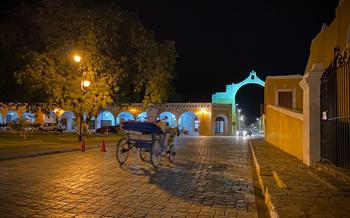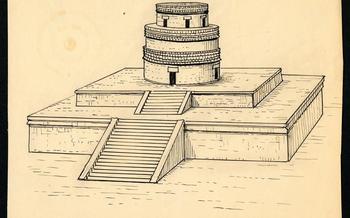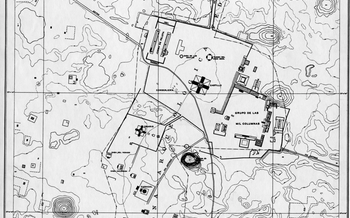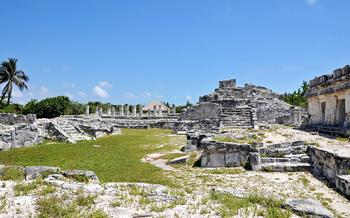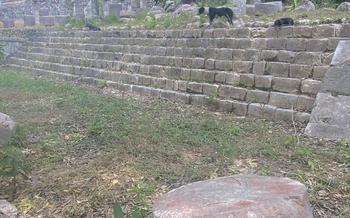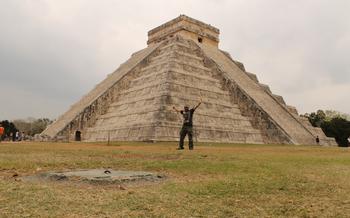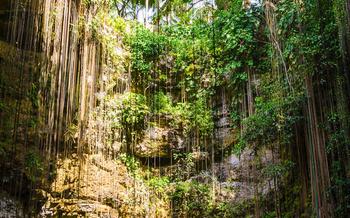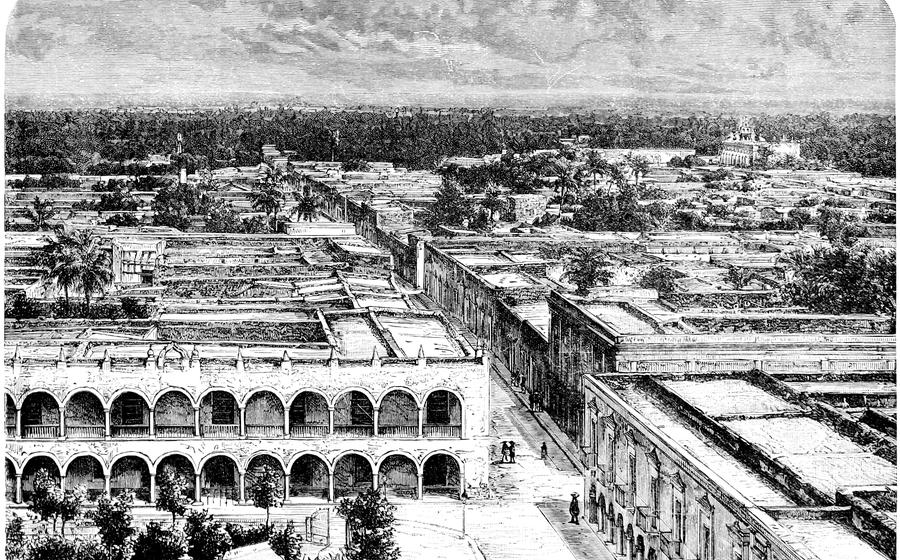
Mayapan Archaeological Zone
- Exploring the Ruins: A Journey Through Time
- The Castillo: A Symbol of Mayan Power and Prestige
- The Temple of Kukulcan: A Place of Ritual and Worship
- The Market: A Hub of Mayan Trade and Exchange
- The Cenote: A Sacred Water Source
- The Ball Court: A Place of Competition and Ritual
- The Residential Areas: A Glimpse into Mayan Daily Life
- The Royal Palace: A Center of Mayan Governance
- The Workshops: A Showcase of Mayan Craftsmanship
- The Museum: Preserving Mayan History and Culture
- The Surrounding Nature: A Tropical Paradise
- Practical Tips for Visiting Mayapan
- Cultural Etiquette and Respect:
- Insider Tip: Off-the-Beaten-Path Gems:
Exploring the Ruins: A Journey Through Time
As you step through the ancient gates of Mayapan, you embark on a journey through time, transported back to the era of the Maya civilization. The city's layout, meticulously planned and executed, unfolds before you, showcasing the Maya's advanced urban planning skills.
Strolling along the wide sacbeob, or causeways, you encounter an array of structures, each serving a distinct purpose. The towering pyramids, with their intricate facades and imposing presence, command attention. These colossal monuments were not merely places of worship but also served as tombs for the city's rulers and elite.
Among the notable structures, the Temple of Kukulcan stands out with its iconic serpent columns and elaborate carvings depicting Maya deities. This temple was a sacred place where religious rituals and ceremonies were performed, invoking the divine powers of the feathered serpent god, Kukulcan.
As you wander through the ruins, you can't help but be struck by the immersive experience. The silence is punctuated only by the chirping of birds and the gentle rustling of leaves, creating an atmosphere of tranquility that transports you to another time.
The Castillo: A Symbol of Mayan Power and Prestige
Among the impressive structures of Mayapan, the Castillo stands as a symbol of Mayan power and prestige. This majestic pyramid, rising amidst the ruins, captivates visitors with its architectural grandeur and intricate carvings. The pyramid's massive base and steep sides lead to a summit that offers breathtaking views of the surrounding landscape.
The Castillo, also known as the Pyramid of Kukulcan, served as the focal point of religious and political ceremonies in ancient Mayapan. Its towering height and imposing presence reflect the Maya's deep reverence for their deities and their commitment to maintaining a strong and centralized government.
As you ascend the pyramid's steps, you'll notice intricate carvings adorning the walls, depicting scenes from Mayan mythology and showcasing the exceptional craftsmanship of the Mayan people. These carvings provide a glimpse into the beliefs and practices of the ancient Maya, offering insights into their rich cultural heritage.
The Castillo is not just an architectural marvel but also a testament to the Maya's deep connection to their environment. Built in harmony with the natural surroundings, the pyramid aligns with the sun's position during the spring and fall equinoxes, showcasing the Maya's advanced knowledge of astronomy and their ability to predict seasonal changes.
The Temple of Kukulcan: A Place of Ritual and Worship
Amidst the ruins of Mayapan, the Temple of Kukulcan stands out as a testament to the Maya's deep religious beliefs and spiritual practices. Dedicated to the feathered serpent god Kukulcan, the temple served as a sacred site for rituals, ceremonies, and worship. Its intricate carvings and symbolism offer a glimpse into the complex religious mythology of the Maya.
The temple's architectural design reflects the Maya's advanced understanding of astronomy. Aligned with the cardinal directions, the temple's orientation allowed the Maya to track the movements of the sun and stars, which held great significance in their religious beliefs. The temple's facade is adorned with elaborate carvings depicting Kukulcan, along with other deities and mythical creatures, further emphasizing its religious significance.
Inside the temple, a series of chambers and passageways leads to a central sanctuary, where religious ceremonies and rituals were performed. The walls are adorned with murals and paintings that depict scenes from Maya mythology and religious practices, providing a glimpse into the spiritual world of the ancient Maya. The temple's acoustics were also carefully designed to create a reverberating effect, enhancing the atmosphere of rituals and ceremonies.
The Market: A Hub of Mayan Trade and Exchange
The market held a prominent position in Mayan society, serving as a vibrant hub for trade and exchange. Beyond its bustling economic activities, the market played a pivotal role in cultural interactions and social gatherings. Here, merchants from distant corners of the Mayan realm converged, exchanging their diverse wares and ideas. The market was not merely a place of commerce; it was a meeting point where people from different communities forged connections, shared stories, and celebrated their shared Maya heritage.
The variety of goods traded at the market reflected the diverse needs and skills of the Maya people. Farmers brought their freshly harvested produce, from sweet maize to juicy fruits, to sell or barter. Artisans displayed their intricately crafted pottery, textiles, and jewelry, each piece a testament to their exceptional craftsmanship. Exotic goods from far-off lands, such as obsidian, jade, and brightly colored feathers, were also highly sought after.
The market was not just about buying and selling; it was a place where people from different walks of life came together to socialize and exchange news. Merchants shared tales of their travels, farmers discussed the latest agricultural techniques, and artisans showcased their newest creations. Through these interactions, knowledge and ideas were disseminated, contributing to the cultural and intellectual growth of the Maya civilization.
The Cenote: A Sacred Water Source
Cenotes, natural sinkholes filled with groundwater, held profound importance in Mayan culture. The cenote at Mayapan served both ritualistic and practical purposes. It was believed to be a portal to the underworld, Xibalba, and a source of divine communication. Mayans conducted ceremonies and offerings at the cenote, seeking guidance and protection from the gods.
Practically, the cenote was a vital water source for the Mayan community, especially during the dry season. It provided fresh water for drinking, cooking, and irrigation. The Mayans developed intricate water management systems to channel the cenote's water to different parts of the city, ensuring a reliable water supply.
Beyond its practical and spiritual significance, the cenote's natural beauty captivated the Mayans. The deep, crystal-clear water, surrounded by lush vegetation, created an enchanting and serene atmosphere. The cenote's unique ecosystem supported a diverse array of aquatic life, including fish, turtles, and water birds, contributing to the overall biodiversity of the region.
The Ball Court: A Place of Competition and Ritual
Among the many structures within the Mayapan Archaeological Zone, the ball court holds a significant place. In ancient Maya culture, the ball game was more than just a sport; it held deep religious and symbolic meanings. The ball court at Mayapan is one of the largest and best-preserved in the Maya region, providing insights into the cultural significance of this ancient game.
The ball court is an open area with two sloping sides, each topped with a stone platform. These platforms were used by the players to hit the ball, which was made of solid rubber and weighed several pounds. The rules of the game are not fully understood, but it is believed that the goal was to keep the ball in play as long as possible without letting it hit the ground.
The ball game was not just a competition but also a ritual. It was often associated with agricultural ceremonies, as it was believed that the outcome of the game could influence the fertility of the land. The ball court was also a place where important events and ceremonies were held, such as the installation of new rulers or the celebration of victories.
The Residential Areas: A Glimpse into Mayan Daily Life
The residential areas of Mayapan offer a fascinating glimpse into the daily lives of the ancient Maya. These neighborhoods were carefully planned and organized, with houses arranged in rows along narrow streets. The houses themselves were typically small and made of perishable materials such as wood and thatch. However, some of the larger houses were built of stone and had multiple rooms. Inside the houses, the Maya lived, cooked, and slept. They also kept their belongings, such as pottery, tools, and clothing, in the houses.
The layout and organization of the residential areas provide insights into Mayan social structure and family life. The houses were typically grouped together in clusters, with each cluster representing an extended family or clan. This suggests that the Maya lived in close-knit communities and that family was an important part of their social structure.
The residential areas also contain a number of public structures, such as temples, schools, and workshops. These structures suggest that the Maya had a complex social and political organization. The temples were used for religious ceremonies and rituals, while the schools were used to educate the children of the community. The workshops were used to produce a variety of goods, such as pottery, textiles, and tools.
The Royal Palace: A Center of Mayan Governance
The Royal Palace stands as a testament to the political and administrative power of the Maya rulers. This grand structure served as the seat of government, where the halach uinic, or paramount ruler, conducted state affairs and presided over ceremonies. The palace complex encompasses a series of interconnected buildings arranged around a central courtyard. Its impressive architecture showcases the Maya's advanced construction techniques, featuring vaulted ceilings, intricate stone carvings, and elaborate stucco decorations.
Within the palace chambers, the Maya elite conducted their political and administrative duties. They discussed matters of governance, received foreign dignitaries, and made decisions that affected the entire kingdom. The palace also served as a venue for important rituals and celebrations, where the Maya leaders strengthened their ties with the divine and reaffirmed their authority.
One of the most notable features of the Royal Palace is its symbolic significance. The complex's layout and iconography were carefully designed to reflect the Maya's cosmological beliefs and divine kingship ideology. The central courtyard, for example, represents the center of the universe, while the surrounding buildings symbolize the four cardinal directions. The palace's decorations depict various deities, mythological scenes, and historical events, reinforcing the idea of the ruler's divine lineage and authority.
The Workshops: A Showcase of Mayan Craftsmanship
The Mayapan Archaeological Zone is not only home to grand structures and historical significance but also boasts a remarkable collection of workshops that provide a glimpse into the intricate craftsmanship of the ancient Maya. These workshops, once bustling with skilled artisans, produced a diverse range of goods that served both practical and decorative purposes.
From intricate pottery and delicate jewelry to finely woven textiles and carved wooden objects, the artisans of Mayapan showcased their exceptional skills and creativity. Visitors can explore these workshops and admire the remnants of their craft, gaining insights into the daily lives and economy of the ancient Maya.
The Museum: Preserving Mayan History and Culture
Within the Mayapan Archaeological Zone, a treasure trove of knowledge awaits visitors at the on-site museum. Dedicated to preserving and showcasing the rich history and culture of the Maya, this museum houses a diverse collection of artifacts and exhibits that provide invaluable insights into the ancient civilization.
Artifacts ranging from intricate pottery and sculptures to tools and weapons offer a glimpse into the daily lives, customs, and craftsmanship of the Maya. Interactive displays and educational exhibits bring to life the complex social structure, religious beliefs, and advanced knowledge systems that defined Mayan society.
The museum also hosts cultural events and educational programs, inviting visitors to delve deeper into the fascinating world of the Maya. Through lectures, demonstrations, and workshops, visitors can gain a comprehensive understanding of Mayan culture and its enduring legacy.
Whether you're a history buff, an archaeology enthusiast, or simply curious about the ancient Maya, a visit to the museum is an essential part of your exploration of the Mayapan Archaeological Zone. Immerse yourself in the stories of this remarkable civilization and discover the secrets that lie beneath the ruins.
The Surrounding Nature: A Tropical Paradise
Nestled within the lush Yucatan Peninsula, the Mayapan Archaeological Zone is a haven for nature enthusiasts. Embark on a journey through the surrounding tropical paradise, where vibrant flora and diverse fauna thrive. Stroll along nature trails that wind through dense forests, home to an array of plant species, including towering trees, exotic flowers, and medicinal herbs. Gaze in awe at the vibrant plumage of tropical birds that flit amidst the branches, creating a symphony of sound. Keep an eye out for shy creatures like deer, monkeys, and iguanas, which roam freely within this protected ecosystem.
The cenote, a natural sinkhole filled with crystal-clear water, is a captivating sight. Swim in its refreshing depths, snorkel amidst schools of colorful fish, or simply relax on its shores and soak in the tranquility. The surrounding vegetation provides a verdant backdrop, creating a picturesque oasis. Conservation efforts are actively underway to preserve this delicate ecosystem, ensuring its beauty and biodiversity for generations to come.
Take advantage of the opportunity to explore the nearby nature reserves, offering a chance to connect with nature on a deeper level. Embark on guided nature walks, led by knowledgeable local guides who share insights into the unique flora and fauna of the region. For birdwatching enthusiasts, the area is a haven, with a diverse array of species to spot, including colorful parrots, majestic eagles, and tiny hummingbirds. Whether you're a seasoned naturalist or simply seeking a serene escape, the surroundings of Mayapan Archaeological Zone offer an unforgettable experience.
Practical Tips for Visiting Mayapan
Timing Your Visit: - Aim to arrive early in the morning to avoid the midday heat and crowds. - Consider visiting during the dry season (November to April) for pleasant weather.
Essential Items: - Bring plenty of water, as there are limited facilities within the archaeological zone. - Sun protection, including sunscreen, a hat, and sunglasses, is crucial. - Wear comfortable shoes suitable for walking on uneven surfaces.
Exploring Beyond Mayapan: - Combine your visit with a trip to the nearby cenotes of Homún or Cuzamá for a refreshing swim. - Visit the colonial city of Mérida, about an hour's drive away, for its colorful streets, vibrant markets, and historical attractions.
Respecting Local Customs: - Be mindful of local customs and traditions, and dress modestly when visiting Mayan communities. - Ask permission before taking photos of local people, and always be respectful of their privacy.
Cultural Etiquette and Respect:
When visiting Mayan archaeological sites, it's essential to be mindful of the cultural significance and the need for respectful behavior. Prioritize preserving the integrity of the ruins by avoiding touching or climbing on them. Seek permission before entering any sacred spaces or taking photographs of local people. Remember that these sites are not just tourist attractions but places of deep cultural and spiritual importance to the Maya. Engage with local communities with respect and curiosity, learning about their traditions and customs. By doing so, you'll not only enhance your experience but also contribute to the preservation of Mayan cultural heritage.
Insider Tip: Off-the-Beaten-Path Gems:
Venture beyond the main attractions to discover hidden gems that offer a unique glimpse into Mayan culture. Explore the Temple of the Warriors, located in the western part of the site, with its well-preserved frescoes depicting Mayan warriors engaged in battle. For a serene escape, seek out the Cenote Xlacah, a secluded cenote with crystal-clear waters, surrounded by lush vegetation and offering a tranquil spot for relaxation and contemplation. Don't miss the opportunity to visit the nearby Hacienda Sotuta de Peon, a beautifully restored 18th-century hacienda that provides insights into the region's colonial past and offers guided tours, horseback riding, and traditional Mayan cooking classes. These off-the-beaten-path gems will reward you with a deeper appreciation for the rich history and cultural heritage of Mayapan.
